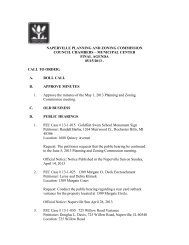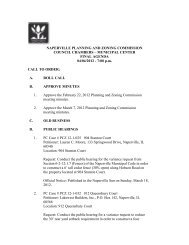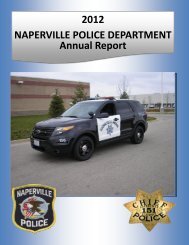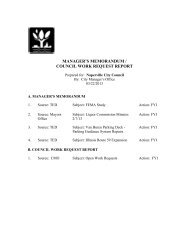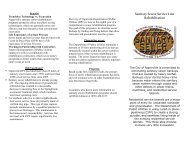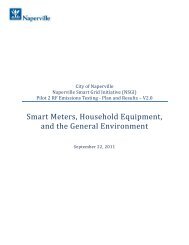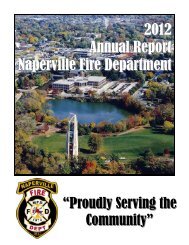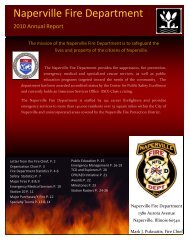Naperville city council presentation - City of Naperville
Naperville city council presentation - City of Naperville
Naperville city council presentation - City of Naperville
You also want an ePaper? Increase the reach of your titles
YUMPU automatically turns print PDFs into web optimized ePapers that Google loves.
CALL TO ORDER:A. ROLL CALL:B. SMART GRIDNAPERVILLE CITY COUNCIL MEETINGCOUNCIL CHAMBERS – MUNICIPAL CENTERFINAL AGENDA12/07/20096:00 p.m. – CLOSED SESSION7:00 p.m. – OPEN SESSION FOR PUBLICC. FY11 FISCAL FORCAST #2D. ADJOURNMENT:Any individual with a disability requesting a reasonable accommodation in order toparticipate in a public meeting should contact the Accessibility Coordinator at least48 hours in advance <strong>of</strong> the scheduled meeting. The Accessibility Coordinator can bereached in person at 1350 Aurora Avenue, <strong>Naperville</strong>, IL., via telephone at 630-420-6725 or 630-305-5205 (TDD) or via e-mail at manningm@naperville.il.us. Everyeffort will be made to allow for meeting participation.
Case For Supporting theSmart Grid Investment GrantDecember 7, 2009Business in the Right Direction. Go West.
AgendaIntroductionBackgroundProposed SolutionBenefitsCostsTimeline & ApproachQ&A2
INTRODUCTIONExecutive SummaryWhat are we proposing? Endorsement <strong>of</strong> <strong>Naperville</strong> Smart Grid Initiative project Approval to proceed with DOE negotiations for a $10,994,110Grant Approval <strong>of</strong> $10,994,110 in matching funds to complete<strong>Naperville</strong>’s Smart Grid InitiativeWhy will it be good for <strong>Naperville</strong>? Lower energy costs and better demand-side managementReduces wholesale bulk power purchases from IMEAProvide customer usage feedbackControls energy cost delivery with Time <strong>of</strong> Use ratesPrepares for upcoming plug-in cars and customer-owned alternative energysources Empower customers to lower their electric bills Utility and customers will save through demand-side savings andenergy efficiency improvements in the distribution network3
INTRODUCTIONExecutive Summary (continued)Net Benefit <strong>of</strong> $81M over 15 years (NPV <strong>of</strong> $52M)5
BackgroundARRA grant overviewReasons for grant application6
BACKGROUNDAmerican Reinvestment & Recovery Act (ARRA) In 2008, President Obama enacted ARRA to stimulate innovation andjob creation in several economic areas Specifically, the U.S. Department <strong>of</strong> Energy (DOE) issued Smart GridInvestment Grants (SGIG)Designed to advance the DOE’s “Smart Grid Functions,” which advance thetechnology and interoperability <strong>of</strong> the grid, manage functions without humanintervention, and use digital controls to manage and modify electri<strong>city</strong> demand andcongestionWinning applicants demonstrated:• Shovel-readiness• Highly secure communications network• Sound business case• Technology interoperability• Detailed project planOut <strong>of</strong> over 500 applicants, <strong>Naperville</strong>’s proposal was one <strong>of</strong> 100approved, and the only utility receiving SGIG funding in Illinois7
BACKGROUNDNeed for better demand-side management LoadReasons for SGIG ApplicationThe electric peak load on the system is roughly 380 Megawatts (MW)1.5 million Megawatt Hours (MWH) annuallyGenerated by 145,000 citizens, as well as commercial and industrial clientsElectric load is expected to keep growing with the growth <strong>of</strong> electronic devices in thehome plus the addition <strong>of</strong> PHEV’s coming to <strong>Naperville</strong> over the next 5-10 years Purchased bulk power contract will change<strong>Naperville</strong>‘s power is directly purchased wholesale in a fixed 4-year contract tohedge risk against rising electri<strong>city</strong> costsIn 2011, the contract will shift to IMEA rates with a demand and energy componentThe demand component will significantly impact overall energy costs• This creates an opportunity to use Time <strong>of</strong> Use rates to shift customer demandto <strong>of</strong>f-peak periods to lower wholesale power purchase costs8
BACKGROUNDReasons for SGIG Application (continued)Respond to macro trends in the electric utility industry Environmental concernsGreenhouse gasesCarbon cap & tradeIntroduction <strong>of</strong> renewable methods <strong>of</strong> energy generation Shifting grid demandsPHEV/EV impactsBi-directional flow (net metering) Customer choicesSource <strong>of</strong> power (e.g. renewables: solar, wind, geothermal)When to consumeData-driven decision makingIncentives to conserveWith current systems, <strong>Naperville</strong> is limited in capability tosupport these trends9
BACKGROUNDWhat’s driving these changes?Environmental DriversCarbon cap & trade, greenhouse gases,support for renewables, foreign oildependencyTechnical DriversSupport customer choice, gridinteroperability, aging infrastructure,customer choice, PHEVs, cyber securityNATIONAL TRENDS•8.3 million smart meterscurrently deployed•18 million smart meterswill be deployed throughStimulus Grants• Future load increase fromPHEVs (President’s goal <strong>of</strong>1 million cars on the roadby 2015)REGIONAL TRENDS•ComEd holding pilot with130,000 smart meterseven without a grant•ICC driving ComEd toimplement Smart Gridtechnologies by approvingrecovery in rate baseLOCAL TRENDS•Move to IMEA rates in2011 require betterdemand sidemanagement to controlcost• Rising usage = risinggeneration•Increasing interest inrenewables• Successful pilot programs• Online billing adoption(already 20% in <strong>Naperville</strong>)10
Proposed SolutionOverviewBenefitsCosts11
SOLUTIONARRA GrantProposed Solution & OutcomesWith financial resources constrained in the current economy, <strong>Naperville</strong> seeks a DOEGrant provided by the American Recovery and Reinvestment Act stimulus bill to drivethese projects to completion on an expedited time scheduleOnce the DOE grant and <strong>Naperville</strong> financing is successfully obtained, projects can beginVisionFinish the <strong>Naperville</strong> Smart Grid Initiative and realize the benefits by providing themissing infrastructure, s<strong>of</strong>tware applications, and data management capabilitiesOutcomesDecreased demand: Shifting load to <strong>of</strong>f-peak times saves moneyImproved efficiency: Having customers help enable efficiency and decrease demandwith the help <strong>of</strong> customer usage feedback and improved efficiency in the distributionnetworkPrepare for future generation and loads: Support distributed renewable generation in<strong>Naperville</strong> with net-metering, and support Plug-in Hybrid Electric Vehicle charging12
SOLUTIONHow to Achieve the Outcomes Enable new optional rates that can provide lower cost <strong>of</strong>f-peakelectric prices (Time <strong>of</strong> Use rates vs. flat rates) Provide customers with tools that encourage decreased demand andincreased efficiency (ePortal and home display) Distribute electri<strong>city</strong> more reliably and efficientlyKey Components• 57,323 smart meters, including theinfrastructure to support water meters• Time <strong>of</strong> Use and Critical Peak Pricing rates• Customer home energy displays with realtimeusage information (optional)• Enhancements to Customer InformationSystem• Enhancement to website including ePortalwith hourly usage information• Automated substations and distributionpoints• Complete fiber build to all substations• Load Control Relays to reduce peakdemand• Meter Data Management System• Outage and Distribution ManagementSystems• Marketing and customer changemanagement programs• Asset Management System that interfaceswith <strong>city</strong>wide initiative13
SOLUTIONExample: Customer Usage Information Customers can view theirpeak vs. non-peak usage: Hourly, view historichourly usage throughcustomer ePortal(available to all customers) Real-time, through ahome energy display(optional) Using this data, acustomer may move theirenergy usage to non-peakhours to take advantage<strong>of</strong> Time <strong>of</strong> Use rates anddecrease overall usage tosave moneyExample: Real-time Home Energy Display14
SOLUTIONCustomer PrinciplesSecurity & Privacy All customer information will be secure and safe because <strong>of</strong> existing<strong>Naperville</strong> policies and stringent requirements from the DOE grant Measures to ensure customer privacy include the following:Will not release energy usage (consumption) data on single customers through theFreedom <strong>of</strong> Information Act (FOIA)May release aggregate data for trending to outside parties, but customer informationwill be removed (e.g. personal identifiable information, PID)Will use single and bulk customer information for <strong>Naperville</strong>’s internal businesspractice, engineering studies, and cost estimatesTransparency & Customer Relations <strong>Naperville</strong> will be as open as possible with spending and projectstatus to the general public and federal agenciesWill leverage <strong>city</strong> website to communicate project updatesTransparency will also be apparent through DOE and Recovery.gov website Active communications to customers on the changes being made toelectric service, their additional choices, and their related benefits15
SOLUTIONWhat are the benefits?Lower PeakDemandFewer LineLossesFewer PowerInterruptionsDecreasedEnergy UseLowerConsumerCostsLowerCarbonEmissionsJobs Createdor Saved26 Megawatt(6.31%)reductionduring peakperiods by20231.5% annualline lossreductionby 20235% annualreduction <strong>of</strong>customeroutageminutesby 2012Totaldecrease <strong>of</strong>819Gigawattsby 2023Approx.$22,000,000saved by2023180,000‐tondecrease ingreenhousegases by2023139 jobscreated overthe 3yearproject *Demand-side savings = lower wholesale power purchase = lower cost* Job details:• 4.5 full time equivalent (FTE) directly to utility• 70.5 FTE consultants, contractors, and vendors• 64 FTE indirectly to utility suppliers and utility/ESCO jobs16
SOLUTIONWhat are the benefits? (continued)OperationalBenefits• Reduced outages• Improved power quality• Resource optimization• Less manual inspection• Remotedisconnect/reconnect• Reduction in meterreading expenses• Fewer outage-relatedcalls• Improved bill accuracy• Replaces aginginfrastructureFinancialBenefits• Reduction in energy theft• Fewer uncollectableaccounts• Reduction in energydemand• Reduced consumptionthrough rates,technologies, and systemupgrades• Aligns with existing<strong>city</strong>wide AssetManagement projectSocietal /CustomerBenefits• Reliability improvements• Reduced greenhousegas emissions• Improved bill accuracy• Customer usagefeedback and choice• Enable distributedrenewables• Support PHEV smartcharging => lessdependence on foreignoil17
SOLUTIONHow much will it cost?Forecasted Cash Needs Year 1: $7,528,574 Year 2: $12,149,362 Year 3: $2,310,284Personnel &BenefitsFinancial Summary$1,932,639 9%Equipment $11,650,936 53%ContractedServices$8,404,647 38%Subtotal $21,988,220 100%The DOE grant requiresall money be spentwithin 36 monthsLess: FederalFunding from DOEGrant<strong>Naperville</strong>’sTotal$10,994,110 50%$10,994,110 50%18
Approach and TimelineHow will it happen?Next steps19
APPROACH AND TIMELINEHow will it happen? Several concurrent projects will be executed over 36 monthsA three-year roadmap will establish how to manage and execute all projectsMilestones by Year2010•Procurement &Implementation <strong>of</strong> AMIand MDMS•Initial smart meterdeployment•CIS modificationscompleted• Distribution networkefficiency pilot (voltageconservation)2011• Asset, project & workflowmanagement system•Home Area Network<strong>of</strong>fered to customers•Deploy Substation &Distribution Automation•Deploy OutageManagement &Distribution Managementsystems• Introduce customer Time<strong>of</strong> Use/Critical Peak Pricingrates2012•All Smart Meters deployed• Finished customereducation programs• Projects completeProject Management and Quality AssuranceCustomer Change Management20
APPROACH AND TIMELINEHow will it happen? (continued) Joint teams led by internal and external subject matter experts Collaboration between DPU-E and other <strong>city</strong> departments Program and Change Management Office oversees project planning,execution, and status reportingProgram & ChangeManagement Office21
APPROACH AND TIMELINEImmediate next steps<strong>City</strong> Approval to ProceedNegotiate with DOEHow do we move forward?Next 45 daysSmart Grid Initiative Consultant RFPCreate Reporting Process and PlanCreate a Integrated Resource andImplementation PlanCreate DOE Level 1 and Level 3 ProjectPlanSubsequent30 daysCreate DOE Reporting Plan22
SummaryWhat are we asking for? Endorsement <strong>of</strong> the <strong>Naperville</strong> Smart Grid Initiativeproject Permission to negotiate and finalize the $11 millionaward with Department <strong>of</strong> Energy for <strong>council</strong>approval (January 2010) Commitment for matching funds <strong>of</strong> $11 million inbonds $7 million 2010 $4 million 201123
Q&ABusiness in the Right Direction. Go West.24
AppendicesFuture pro<strong>of</strong> pointsSmart Grid Initiative DetailsFAQs25
Future Pro<strong>of</strong> PointsCustomer Defined Load Control and Home AutomationDistributed Renewable Generation – (e.g. Solar, Wind, Geothermal)Plug-In Hybrid Electric Vehicles (PHEV)/Electric Vehicles (EV)26
FUTURE PROOF POINTSCustomer-defined load control By utilizing a Home Area Network (HAN) capable device, a customercan accurately gauge their energy usage and make intelligentdecisions related to the following:Utilization <strong>of</strong> resourcesTiming <strong>of</strong> energy consumptionPrice <strong>of</strong> energy when load is activated Customers can remotely monitor and actively control their energyusage pr<strong>of</strong>ile via Internet based customer portals Example:Program air conditioning and pool heaters to run at the most efficient periods <strong>of</strong> theday, along with the cheapest timesA customer sees an increase in price through customer usage feedback, andproactively curtails their energy consumption27
FUTURE PROOF POINTSSupport <strong>of</strong> distributed renewables (net metering) Customers ambitious enough to procure their own renewable powersystems will be able to actively participate in energy-recoveryprograms with the <strong>City</strong> <strong>of</strong> <strong>Naperville</strong> Customers could also contribute electri<strong>city</strong> to the overall grid and becompensated for the effortThe AMI solution, IT systems and Smart Meters will support net meteringNet metering is the ability to keep track <strong>of</strong> how much energy along with when it istransferred to the home or to the network Bi-directional communication between the meters and theinfrastructure will allow the network to monitor the impact <strong>of</strong>“Distributed Renewable Generation” on the <strong>Naperville</strong> distributionnetwork28
FUTURE PROOF POINTSPlug-in Hybrid Electric Vehicle (PHEV) charging Federal goal <strong>of</strong> 1M PHEV/EV cars on the road by 2015A benefit <strong>of</strong> TOU pricing is hybrid vehicles can be charged during the mostcost-efficient period <strong>of</strong> their inactivity – typically during the night.Significant penetration <strong>of</strong> PHEV/EV will require smart grid solutions to avoidadditional build out <strong>of</strong> the distribution networkOne PHEV can add 50% or more load to the average home energy load29
Smart Grid Initiative DetailsSummary <strong>of</strong> initiativesDetailsTimelineMetricsBenefit detailsDOE requirements30
SMART GRID INITIATIVETechnology Project DescriptionSummary <strong>of</strong> InitiativesTools and rates that decrease demand and increase efficiencyCustomer InformationSystem (CIS)ePortalAdvanced MeteringInfrastructure (AMI)Meter Data ManagementSystem (MDMS)Smart MetersHome Area Network(HAN)Upgrade existing CIS to supportadvanced pricing and ePortalDevelop as an add-on to the<strong>Naperville</strong> CIS applicationCreate an RFP and implement AMItechnologiesCreate an RFP and implementMDMSCreate an RFP and install SmartMetersPromote optional customerinstallation <strong>of</strong> Home Area NetworkAllows for advanced pricing programs and to provide information for newdemand response programsAchieves energy conservation by enabling customers to view their energyconsumption for any period via the InternetAllows for two-way communications between the customer’s home meter and<strong>Naperville</strong> DPU-EEnables utilities to manage large volumes <strong>of</strong> meter data generated fromadvanced metering infrastructure (AMI) systemsIdentifies consumption in more detail than conventional meters and transfersthat information back to <strong>Naperville</strong> DPU-E for remote monitoring andtroubleshooting, customer data <strong>presentation</strong>, remote disconnect/reconnectand billing purposesAn extension <strong>of</strong> smart metering intelligence into the home itself, connectingthe meter to major power-consuming devicesLoad ControlManagement System(LCMS)Time <strong>of</strong> Use/Critical PeakPricing ratesInstall for remote control <strong>of</strong> bothcommercial and residentialcustomer loads. Optional customercontrol, optional utility control withcustomer incentive.Implement Time <strong>of</strong> Use and CriticalPeak Pricing rate structuresProvides direct load control <strong>of</strong> select customers, or unique load <strong>of</strong> customers,during high-load conditions or emergency system eventsDemand response enablers that encourages and rewards load shifting andbehavioral change31
SMART GRID INITIATIVEDistribute electri<strong>city</strong> more reliably and efficientlyTechnology Project DescriptionSummary <strong>of</strong> Initiatives (continued)Geographic InformationSystem (GIS)Distribution Automation(DA)Substation Automation(SA)Volt/VAR OptimizationApplicationEnterprise AssetManagement System(AMS) and Project/WorkFlow ManagementSystems (WFMS)Outage ManagementSystem (OMS)Distribution ManagementSystem (DMS)Acquire NAP-wide SU-ELA or equivalentpricing structureFinish installation <strong>of</strong> feeders not alreadyautomatedComplete full connectivity and enable allsubstation-automated devicesCreate an RFP and install s<strong>of</strong>tware andremote sensorsAcquire and install capacitorsInterface with <strong>city</strong>-wide NAMS initiativeImplement Outage Management SystemImplement Distribution Management SystemIntegrates hardware, s<strong>of</strong>tware, and data for capturing, managing,analyzing, and displaying all forms <strong>of</strong> spatially referencedinformationAllows for monitoring <strong>of</strong> critical feeders to reduce outage durationsand helps alleviate overload conditionsEnables data acquisition from the power grid in a decentralizedstructureProvides for a flat 120-volt distribution feeder pr<strong>of</strong>ile andplacement/control <strong>of</strong> capacitors at the appropriate locations alongthe feeders for voltage support and to supply VARs as neededSystematic method <strong>of</strong> prioritizing and referencing enterprise assetsto continuously provide adequate service coverage, whileminimizing human and capital expenses required to deliver suchperformanceDispatches outage orders from the Outage Management System,sending crews via the shortest route and tracks crew locationsClassify and identify outage conditions for proper staffing and repair<strong>of</strong> fault conditionsSecures the SCADA functionality <strong>of</strong> devices located on thedistribution system32
SMART GRID INITIATIVEProject ElementsDetermine Modifications to CIS to enable AMICustomer Information System (CIS)Evaluate and upgrade the existing CIS application to Allow for advanced pricing programs Provide information for new Demand Response ProgramsDetermine ePortal strategy based on advanced functional capability <strong>of</strong> the current CIS tomeet or not meet advanced rate structuresTimelineElement / Task Deliverable Start FinishProcure CIS Module Determine Requirements Dec 2009 Jan 2010Install Interval PricingModuleCut Over ExistingCustomersInstall and Run Validation Pilotw/ Smart MeterConvert Installed Smart MeterCustomersFeb 2010 Sep 2010Sep 2010 Nov 201033
SMART GRID INITIATIVECustomer Information System (CIS) – ePortalDevelop ePortal as an add-on to the CIS applicationBased on capability, or lack there<strong>of</strong>, <strong>of</strong> advanced modules from SunGard HTE to supportadvanced ratesePortal Strategy & DevelopmentE-Portal Strategy and development will include a wide team <strong>of</strong> people from Marketing, IT, DPU-Eand Customer ServiceThis will provide an upgraded CIS for Smart Meter functionality and achieve energyconservation by enabling customers to view their energy consumption for any period viathe Internet34
SMART GRID INITIATIVEAdvanced Metering Infrastructure (AMI)Project Elements AMI procurement, installation, and meter deployment Create RFP and install Smart Meters Create RFP and implement Load Control Management SystemTimelineElement / Task Deliverable Start FinishProcure AMI System Initiate Contract with Vendor Sep 2009 Apr 2010Install AMI CommunicationSystemAMI Infrastructure Site Completion Apr 2010 Oct 2010Field Install Smart MetersTest & Verify Remote DataAcquisition57,000 Meters installed at Customer’spremiseMeter data being received accuratelyand flowing through to customer billJul 2010 Feb 2012Aug 2010 Aug 201035
SMART GRID INITIATIVE COMPONENTSAMI ComponentsAdvanced Metering InfrastructureAllows for two-way communications between the customer’s home meter and NAPIncludes the hardware and s<strong>of</strong>tware that creates a two-way communications network between AMImeters and the backbone that connects to the utility business systems, allowing collection anddistribution <strong>of</strong> the AMI information to customers and the utilityThis infrastructure must provide the connectivity to all the meters in our service territory, which has avery wide variety <strong>of</strong> coverage requirements, from urban to rural and from outdoor meters to those ina basement, or metering closetSmart MetersThese meters identify consumption in more detail than conventional meters and transfer thatinformation through a communications network back to NAP for monitoring, customer data<strong>presentation</strong>, and billing purposesInstallation portion will be able to be separated from AMI and Smart Meter RFP if <strong>Naperville</strong> wantsto deploy or use other vendorLoad Control Management SystemInstall for remote control <strong>of</strong> both customer load and NAPProvides <strong>Naperville</strong> with direct load control <strong>of</strong> selected participating customers, or unique load <strong>of</strong>customers, during high-load conditions or emergency system events. Customer incentives will beavailableTry to move this up work with AMI system, so it can be used to get customer feedback, history, andassist in training the customerThis will help the advanced rate development based upon the lessons learned during deployment36
SMART GRID INITIATIVE COMPONENTSMeter Data Management System (MDMS)Project ElementsEnables utilities to manage large volumes <strong>of</strong> meter data generated from AdvancedMetering Infrastructure (AMI) systemsTeam composed <strong>of</strong> vendor, representative from <strong>Naperville</strong> IT area, and an experiencedsystem integratorWill involve substantial time to configure and testSubject Matter Expert engineers can be brought in to do this work This will be constructing the data system design What events will be stored in MDMS or other system, e.g. PI Server.TimelineElement / Task Deliverable Start FinishPlan – AnalyzeCompleted ProjectRequirementsNov 2009 Feb 2010Design- BuildTechnical ArchitectureSystem CodeApr 2010 Jul 2010Test- Train- Conversion – Deploy Testing/Training Process Plan Jul 2010 Dec 201037
SMART GRID INITIATIVE COMPONENTSRequest for Proposal for AMI technologiesProject Elements Combined RFP effort for the following:Advanced Metering InfrastructureMeter Data Management SystemSmart MetersLoad Control Management SystemHome Area NetworkTimelineElement / Task Deliverable Start FinishDevelop RFP Request for Proposal Jan 2010 Jan 2010Collect Proposals All proposals returned from vendors Mar 2010 May 2010Vendor Selection Vendor chosen to implement solutions May 2010 June 201038
SMART GRID INITIATIVE COMPONENTS<strong>Naperville</strong> Asset Management System (NAMS)Project Elements Implement Asset (AMS) & Project/Work Flow Management System (WFMS) Provides for data warehouse pulling from many data sources to manage projects,resources, and workforce Systematic method <strong>of</strong> prioritizing and referencing enterprise assets to continuouslyprovide adequate service coverage, while minimizing human and capital expensesrequired to deliver such performance Dispatches outage orders from the Outage Management System, sending crews viathe shortest route and tracking crew locations Allows for the streamlined creation, management, and processing <strong>of</strong> capital andoperating projects utilizing available data.TimelineElement / Task Deliverable Start FinishPlan-Analyze Completed Application requirements Jan 2010 May 2010Design-Build Technical architecture System Code May 2010 Mar 2011Integrate with GIS & OMSTest-Train-DeployTest GIS, OMS, EMS Interfaces CaptureWorkforce Effectiveness Capture AssetPreservation BenefitsTesting process planTraining PlanMar 2011 Aug 2011Aug 2011 Oct 201139
SMART GRID INITIATIVEOutage and Distribution Management SystemsProject Elements Outage Management System (OMS) Classify and identify outage conditions for proper staffing and repair <strong>of</strong> fault conditions Industry expert resources may be needed to assist in this implementation Distribution & Energy Management Systems (DMS, EMS) Secures the SCADA functionality <strong>of</strong> devices located on the distribution system Industry expert resources may be needed to assist in this implementation Analyze and determine whether or not to implement a centralized or decentralizedsystemTimelineElement / Task Deliverable Start FinishExecute RFP Select Vendor Aug 2010 Dec 2010Plan-Analyze Completed application requirements Sep 2010 Mar 2011Design-BuildDesign Support OMS Integration andSystem codeApr 2011 Aug 2011Test-Train-Deploy Testing process plan and Training Plan Sep 2011 Nov 201140
SMART GRID INITIATIVE COMPONENTSDistribution and Substation AutomationProject Elements Distribution Automation (DA) Allows monitoring critical feeders to reduce outage durations and helps alleviate overload conditions Need to begin with the distribution planning guidelines and use local <strong>Naperville</strong> engineering staff tocoordinate schemes Substation Automation (SA) – complete all 16 substations Enables data acquisition from the power grid in a decentralized structure Will work with the local <strong>Naperville</strong> substation engineering staff on strategy and deployment Volt/VAR and Phase Balancing – create an RFP, install s<strong>of</strong>tware and remote sensors, andacquire and install capacitors• Provides for a flat 120-volt distribution feeder pr<strong>of</strong>ile and placement/control <strong>of</strong> capacitors at theappropriate locations along the feeders for voltage support and to supply VARs as neededTimelineElement / Task Deliverable Start FinishPlan-Analyze Completed Requirements Oct 2010 Jan 2011Design-Build Design DA Circuits Jan 2011 Apr 2011Test-Train-Deploy Testing process plan Apr 2010 Jun 201141
SMART GRID INITIATIVE COMPONENTSTime <strong>of</strong> Use (TOU) & Critical Peak Pricing (CPP)Project Elements Negotiate new rate Study customer market data Create rates to maximize new contract Market to customers for energy efficiency and behavioral shiftsTimelineElement / Task Deliverable Start FinishRate Study Analysis Rate Study Report Jan 2011 Jan 2011Design- Build Rates Completed Rate sheets Jan 2011 Mar 2011Implement RatesMarketing Plan Roll OutCustomer Adoption ReportMar 2011 Jun 201142
SMART GRID INITIATIVE COMPONENTSHome Area Network (HAN)Project Elements Develop a customer knowledge program These are promoted and supported by <strong>Naperville</strong>, but purchased and installed by eachcustomer at their discretion An extension <strong>of</strong> smart metering intelligence into the home itself, connecting the meter to majorpower-consuming devices This can be started in 2011, after all the system components have been defined A local person can drive this, working to create the ecosystem partners, train them, and get themessage to the customers createdTimelineElement / Task Deliverable Start FinishPlan-Analyze Completed Physical Requirements Jan 2011 Apr 2011Design-BuildCreate HAN equipment add-on proceduresCreate HAN interface to LCMSEnable Local Contractors for InstallationsApr 2011 Sep 2011Deploy HAN Devices Testing Process Plan Sep 2011 Nov 201143
SMART GRID INITIATIVE COMPONENTSTimelineAll project elements are planned to be completed within the DOE-required36-month time frame.44
SMART GRID INITIATIVE COMPONENTSCustomer-level MetricsThese KPIs enable the quantification <strong>of</strong> demand and energy savings along with adoption rates <strong>of</strong> thedifferent customer programs at a level that enables <strong>Naperville</strong> to continually evaluate and optimize thecustomer programs and solutions.45
SMART GRID INITIATIVE COMPONENTSDistribution Network MetricsThese metrics are associated with the Volt/Var optimization solution that will optimize distribution networkpower quality and efficiency.46
APPROACH AND TIMELINEGrant ObligationsProject oversight from Department <strong>of</strong> Energy (DOE), including annual reviews,performance monitoring, site visits, and assistance in issue resolutionReportingWill measure actual performance vs. project estimatesMust comply with monthly, quarterly, annual financial and operational reporting requirements• Monthly progress reporting via web-based project management tool• Quarterly ARRA reporting requirements• Semi-Annual Reporting on Smart Grid Metrics/Results• Special status report (for developments that have significant impact on project)• Final Scientific/Technical Report and supporting dataDOE will provide standard templates for data collection (to define build/impact metrics withmapping to benefits)Federal Audit Audit is required for all federal grants over $500,000ReimbursementAll money is reimbursed on a bi-weekly basisDOE approving <strong>of</strong>ficial will approve invoice no later than 30 days after received, unless billing isimproperDOE funds be spent within 36 months <strong>of</strong> Grant Award47
FAQsSystem reliability questionsSecurity/privacy questionsCustomer service questions48
FAQsHow will this increase reliability?System Reliability Questions All Smart Grid Initiative components will work in tandem to increaseoverall system reliability. Specifically, the following components willhave a direct effect on improving reliability:2-way flow <strong>of</strong> meter information through AMILoad control management systemDistribution AutomationVolt/VAR pilotOutage ManagementHow will this shift demand? Customers have a financial incentive to move their high-consumptionactivities to non-peak times. As a result, less consumption will occur during peak times, and moreconsumption will occur during non-peak times.49
FAQsSecurity/Privacy QuestionsWill my information be secure? <strong>Naperville</strong> will implement stringent cyber-security standards tocomply with the DOE Smart Grid Investment Grant requirements.Will my data stay private? <strong>Naperville</strong> will continue to apply its current policies, including thefollowing:Will not release energy usage (consumption) data on single customers through theFOIAMay release aggregate data for trending to outside parties, but with customerinformation (personal identifiable information, PID) removedWill use single and bulk customer information for our internal business practice,engineering studies, and cost estimatesSigned court order required to release data to law enforcementUnusual trending will continue to be documented• Although <strong>Naperville</strong> will not actively mine meter data in such a manner, suspiciousactivity will be reported to the proper authorities.50
FAQsSecurity/Privacy Questions (continued)What will <strong>Naperville</strong> do to prevent a security breach? <strong>Naperville</strong> will have the following steps in place to ensure security:Adherence to Department <strong>of</strong> Energy cyber security standardsPeriodic scheduled internal and external security auditsTechnical and physical controls (e.g. passwords, locks, encryption)Smart Grid “Lab” for testing security configurationsScheduled reviews with Department <strong>of</strong> Energy to ensure compliance is up to date The creation <strong>of</strong> a Smart Grid Security and Privacy Handbook willensure that all the security procedures, designs, implementations,and policies are supported throughout the project lifecycle.51
FAQsCustomer Service Questions (continued)What if I don’t want to participate? A customer does not have to participate in Time <strong>of</strong> Use rates orCritical Peak Pricing. However, changes to the ePortal and meters will be made regardless<strong>of</strong> customer participation. All customer meters will be replaced.52
Page: 54 - Agenda Item: B.CITY OF NAPERVILLEMEMORANDUMDATE: December 4, 2009TO:FROM:SUBJECT:Douglas A. Krieger, <strong>City</strong> ManagerAllan L. Poole, Public Utilities DirectorProposed 5-Year Capital Improvement Program Budget FY2010-11thru FY2014-15 with Smart Grid DOE GrantACTION REQUESTEDForward this memorandum to the <strong>City</strong> Council to supplement the Power Point <strong>presentation</strong> to bemade by West Monroe Partners and <strong>city</strong> staff at the December 7 workshop on the <strong>Naperville</strong>Smart Grid Initiative and the U.S. Department <strong>of</strong> Energy (DOE) Smart Grid grant award.BACKGROUND/DISCUSSIONFor the past 3 years the 5-year Capital Improvement Program (CIP) budget for the Department <strong>of</strong>Public Utilities-Electric has been held to no more than $12 million per year or $60 million total.Included in this capital budget have been major components <strong>of</strong> the <strong>Naperville</strong> Smart GridInitiative (NSGI) with $8.4 million proposed over the next 5 year period.The $8.4 million has included completion <strong>of</strong> Substation Automation, Distribution Automation,SCADA upgrades, Asset Management, and computer server additions. The grant application toDOE this past August included all <strong>of</strong> these components and the installation hardware ands<strong>of</strong>tware <strong>of</strong> Smart Grid metering, referred to today in the electric utility industry as an AdvancedMetering Infrastructure and Meter Data Management (AMI/MDM).With the DOE 50% matching grant and <strong>Naperville</strong>’s equal share, our revised 5-year CIP is asfollows:Proposed 5-Year Capital Improvement Program BudgetFY 2010-11 thru FY 2014-15 with Smart Grid DOE GrantRevisedProposed CIP less Bond Issuance Proposed CIP5-Year Smart Grid Smart Grid For <strong>City</strong> with Smart GridYear CIP Components Components 50% Share ProjectFY10-11 $12.066 $1.855 $10.211 $7.000 $17.211FY11-12 $12.122 $1.762 $10.360 $4.000 $14.360FY12-13 $11.525 $1.610 $9.615 $9.915FY13-14 $11.755 $1.705 $10.050 $10.050FY14-15 $11.920 $1.470 $10.450 $10.450Totals $59.387 $8.402 $50.985 $11.000 $61.985***All values above are in million dollars***The following bullet points are made in reference to the above chart as follows:FINAL - <strong>City</strong> Council Meeting - 12/7/2009 - 54
Douglas A. Krieger, <strong>City</strong> ManagerPage 2December 4, 2009Proposed 5-Year CIP Program Budget with Smart Grid DOE GrantPage: 55 - Agenda Item: B.• Revised 5-year budget at $61.985 is $2.598 million or 4.37% higher with Smart Grid-<strong>City</strong> 50% portion ($11.0 million) than proposed Budget ($12 million/year x 5 = $60million)• With DOE Smart Grid 50% Matching Grant Award, the <strong>City</strong> benefits with $11.0 millionin additional assets at no cost• <strong>City</strong> benefits by completing Smart Grid components beyond planned $8.4 million forSubstation Automation, Distribution Automation, SCADA Upgrades, and AssetManagement to the $22.0 million level which includes all <strong>of</strong> these and the SmartMetering for all customers• <strong>City</strong> completes Smart Grid in a 3-year period with DOE Grant rather than a much longerperiod well beyond 5 years and benefits much sooner with reduced wholesale powerpurchases (both for demand and energy costs) and rate savings for our correspondingcustomersRECOMMENDATIONForward this memorandum to the <strong>City</strong> Council for their additional information as related to theSmart Grid workshop <strong>presentation</strong> on December 7, 2009.ALP/mmFINAL - <strong>City</strong> Council Meeting - 12/7/2009 - 55




